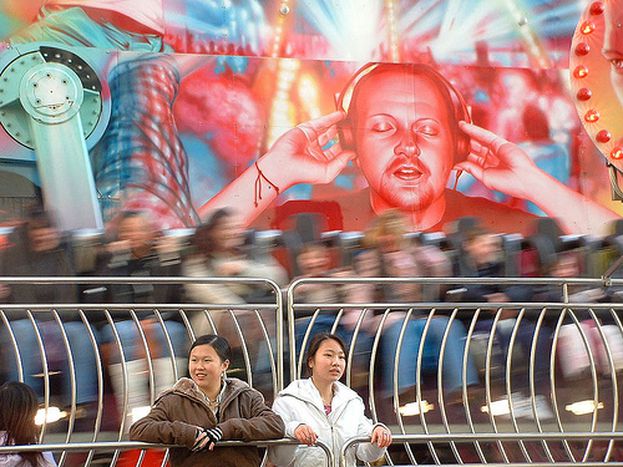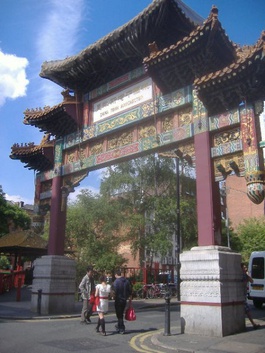
Popping into Chinatown in Manchester
Published on
Translation by:
 Ana D
Ana D
Known as a Chinese village of north England, the neighbourhood is one of the most peculiar in Manchester, being the second largest tourist spot of England after London. One of the odd distinguishing factors of multiculturalism is the local community enclosed in its borders
 The symbol of this Manchester neighborhood is a Chinese arch of the Imperial Ming Dynasty which guards the number of restaurants and business centres in Faulkner Street. Painted in red and golden colors, the arch is decorated with a dragon and a phoenix, the traditional symbols of luck. China gifted what became the first original Chinese arch in Europe to Manchester in 1987. The arch remains the most visible track of Asia in this industrialised city, that has changed both its look and population over the last two decades. The population of this continent has a significant presence, not only because of their historic migration relationship with the city, but also due to the rise of universities able to attract a large number of students from all over the world.
The symbol of this Manchester neighborhood is a Chinese arch of the Imperial Ming Dynasty which guards the number of restaurants and business centres in Faulkner Street. Painted in red and golden colors, the arch is decorated with a dragon and a phoenix, the traditional symbols of luck. China gifted what became the first original Chinese arch in Europe to Manchester in 1987. The arch remains the most visible track of Asia in this industrialised city, that has changed both its look and population over the last two decades. The population of this continent has a significant presence, not only because of their historic migration relationship with the city, but also due to the rise of universities able to attract a large number of students from all over the world.
China, UK and Hakka
This is the case of 20-year-old Chinese student Ting. Having completed his studies in business administration, he now plans to pursue a masters degree. During the four years spent in Manchester, Ting believes that he has not shared a common 'English' lifestyle. Cultural differences between the two nations already mean communication is complicated. He admits that he has not improved his English much during all these years, but, in his opinion, English people do not express lots of interest in Chinese culture either. 'The English people are interested in other European cultures that are much closer to them, but not in our totally different nation,' he alleges.
Despite the large number of Chinese immigrants, integration remains a complicated issue. In 1950, the first immigrants arrived from the rural settlements of the Hakka clan of Hong Kong, in the search of better living conditions. The Hong Kong government had sold their lands to feed an ever-expanding population. The Hakka, who had occupied a privileged position in the farming community, had to work in factories for precarious salaries. This brought some of them to the United Kingdom. However they began to see the real impact of the migration wave only in the sixties and seventies, with the spread of Chinese restaurants and businesses in the city centre.
'A future in England, not China'
Looking for better paid conditions remains one of the main reasons driving the Chinese community to England. Chan is a 32-year-old waiter at Tai Wu, a restaurant favoured by the Asian community in Manchester's Oxford Road. 'I go back to Hong Kong only for short visits,' he explains. 'After living here for six years, I know that I definitely want to stay. My daughter is seven months old. I want her to go to an English school.' Chan knows that education, employment and a good knowledge of English are the basis for integration. It's something that will become easier for further generations.
Gastronomy is where the communities meet
The large number of takeaway restaurants where you can sample a rich menu serving large quantities for a very affordable price is characteristic of Chinatown. In the food district, you can also come across Japanese, Thai and Nepalese cuisines. Chan is especially fond of Wasabi, a Japanese sushi bar offering fresh fish for a reasonable price. As it appears, gastronomy is one point where the Asian community and the other inhabitants of the city meet. Brandon, a 33-year-old native of Manchester, admits that he adores the neighbourhood. 'It's an ideal place to walk about and have a cup of tea. The environment is completely different.' One of his favourite places is a bakery called Wong Wongon Princess Street, where you can taste nice fruit and honey pies. But most of all, he adds, he likes roast pork.
Walking along Chinatown plunges you into a colourful and multicultural world. As a place of contrast and flavours, it shows a young and dynamic city which once faced a migration wave naturally, though integration remains a complicated topic.
Images: main ©mattwi1s0n/Flickr; arch ©Virginia Fernández
Translated from Chinatown en Manchester, ¿símbolo de multiculturalidad o un gueto?


